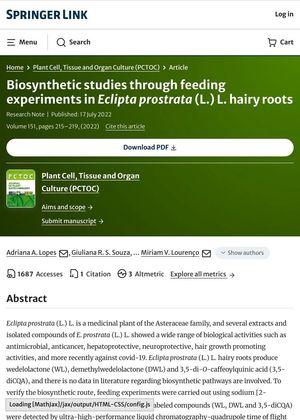Biosynthetic Studies Through Feeding Experiments in Eclipta Prostrata Hairy Roots
July 2022
in “
Plant Cell, Tissue and Organ Culture (PCTOC)
”

TLDR The study found that in Eclipta prostrata roots, coumestans come from acetate and shikimate pathways, and phenylpropanoid is made only through the shikimate pathway.
The research conducted feeding experiments on Eclipta prostrata (L.) L. hairy roots, a medicinal plant known for promoting hair growth. The roots produce wedelolactone (WL), demethylwedelolactone (DWL), and 3,5-di-O-caffeoylquinic acid (3,5-diCQA), whose biosynthetic pathways were previously unknown. The study used sodium [2-13C]acetate, [3-13C]dl-phenylalanine, and 13C-labeled compounds in the experiments, detected by ultra-high-performance liquid chromatography-quadrupole time of flight mass spectrometry. The findings revealed that the metabolic pathways of coumestans (WL and DWL) are derived from acetate and shikimate pathways, while the phenylpropanoid (3,5-diCQA) biosynthesis is exclusively from the shikimate pathway.
